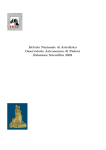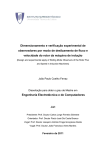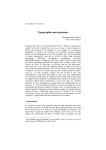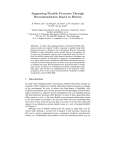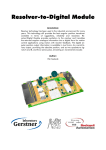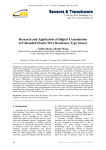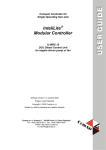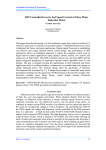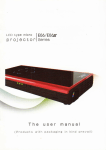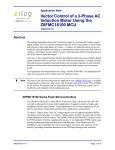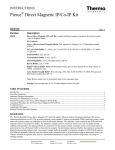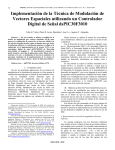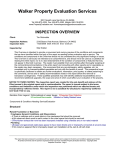Download AC Drive Fault Diagnosis & Detection
Transcript
A Brief survey of AC Drive Fault Diagnosis & Detection Contents: Preface I. Introduction II. Basics of AC Drives PWM Inverter AC Drive Semiconductor Technologies III. Faults in AC Drives AC Power Line Faults Frequency Converter Faults Failure Mechanisms in Power Electronic Components AC Motor Faults IV. Protection of AC Drives Conventional Protection Scheme for VSI AC Drives Standard Industrial AC Drive Protection V. Faults Diagnosis & Detection Methods Expert Knowledge-based Systems On-line Condition Monitoring AC Motor Diagnosis Literature by Petr Kadaník, Prague, December 1998 A Brief survey of AC Drive Fault Diagnosis & Detection Preface This text represents an attempt at a brief report about the present state of evolution of the AC drive fault diagnosis and fault detection. Mostly conference papers, but also journal articles, web pages and product specifications were used to summarize all available pieces of information about this technical area. All the fault diagnosis approaches are presented with a view to a voltagesource inverter AC drive, because of the largest using of this type in the industry. Text is organized as follows. Some background is given in chapter I. Section II briefly reviews AC drive’s main features and topology. Classification of AC drive faults is given in chapter III and a protection of standard AC drives is described in chapter IV. The last chapter contents diagnosis methods with some examples of diagnostic applications. page 2 Prague, December 1998 page 3 I. INTRODUCTION The reliability of power electronics systems is of paramount importance in industrial, commercial, aerospace, health institutions and military applications. The knowledge about the fault mode behavior of an AC drive system is extremely important from the standpoint of improved system design, protection, and fault tolerant control. Plenty of applications can be considered critical applications meaning that they have high targets set for reliability and availability. The requirement is that no single failure would terminate the process. Appropriate means should also be used to monitor the status of the drive and safety of the controlled system. There are many drive system configurations that could be used, but selecting the correct system depends on the needs of the process and cost of the system. The use of an AC drive system (Fig.1) in a critical application requires careful coordination of the AC drive with the AC motor along with a method to accommodate AC power line failures. The actual needs of the process must be known to select a system that is properly designed and provides a reasonable payback period. Fig.1: General Scheme of AC Drive System The importance of incipient fault detection is the cost saving that is realized by detecting potential failures before they occur. Currently, motors are required to be protected by circuit breakers of fuses that interrupt instantaneous fault currents. However these devices are intended only as safety devices and they may protect the motor and nearby personnel from injury due to a fault, but will not warn of potential faults before they occur. Incipient fault detection, on the other hand, allows preventative maintenance to be scheduled for machines that might not ordinarily be due for service and may also prevent an extended period of downtime caused by extensive motor failure. Long time disturbances in technological processes cause big economical loses. In modern plants, thousands of electric motors work together in the manufacturing process. A portion of these applied motors are essential to the process. An unscheduled shutdown occurs if only one of these motors fails. If it was possible to detect a developing fault, for example, an interturn short circuit, then it is possible to schedule an orderly shutdown of the complete process. In these cases, it can be cost effective to continuously monitor the above-mentioned electric motors. Nevertheless, the defective motor will need to be exchanged and repaired. From this reason the problem of fast fault detection and location as well as problem of technical state evaluation (diagnostic) are very significant in the industrial practice. A significant advance has been made in diagnostic by the introduction of artificial intelligence or expert systems. Artificial intelligence involves programming a computer so that it can mimic human thinking. An expert system essentially tends to mechanize the expertise of a human being. A human expert has knowledge, an experience base, and the power of reasoning, judgment and intuition. page 4 A Brief survey of AC Drive Fault Diagnosis & Detection II. BASICS OF AC DRIVES AC drives are being designed into a more demanding group of applications. Originally, the applications were mostly limited to fans and pumps where the energy savings provided all immediate payback for the premium charged. Over the years, the cost of AC drive systems has been decreasing and their performance increasing. AC drives are being applied to overhead cranes, continuous casters, winders, unwinders, extruders and other more demanding applications. The AC machines, especially the cage-type induction motors (IMs), seem to process several distinct virtues in comparison with DC machines. These relate to lower cost and weight, lower inertia, higher efficiency, improved ruggedness and the capability to operate in a dirty and explosive environment due to the absence of commutators and brushes. The speed of an AC machine is related to stator supply frequency which produces the synchronously rotating magnetic field. If frequency is increased to increase speed of the machine, the magnitude of air-gap flux is reduced due to increased magnetizing reactance, and correspondingly the developed torque is reduced. For this reason, an AC machine normally requires variable-voltage variable-frequency power supply for speed control. There are two basic forms of power electronic converters for changing from the fixed AC line frequency to variable motor frequency: cyclo-converter (performs this operation in a single conversion stage) and converters with a DC-link (converter is decoupled into the two sides, Fig.2). The cycloconverter drives are used only in very large horse-power applications. The cost and complexity of power and control circuits make them uncompetitive with other classes of drives in general applications. Fig.2: Simplified diagram of a frequency converter The process of converting DC to AC power is called inversion and it is the inverter which creates the variable frequency from the DC source which is used to drive an IM at a variable speed. In general, two basic types of inverters exist which are totally different in their behavior. The so called Voltage-Stiff (or Source) Inverter abbreviated as VSI is more common and this type of inverter creates relatively well defined switched voltage waveform at the terminals of the motor. The DC bus is maintained as voltage stiff by the use of a large capacitor in the DC link. A voltage source inverter differs from the voltage stiff inverter in that the DC link is established with a DC source (battery for instance). The resulting motor current is then governed primarily by the motor load and the speed. The VSI is also termed a voltage source inverter. However, it is clear that the DC link itself is truly not a power source if the link voltage is supported only by an energy storage element such as a DC capacitor. The VSI is typically subdivided into two forms the so called six step inverter and the pulse width modulated (PWM) inverter. The second type of inverter, the Current Stiff (or Source) Inverter (CSI) provides a switched current waveform at the motor terminals. The DC bus is maintained as current stiff by use of a large inductor in the DC link. The voltage waveform is now governed primarily by the motor load and speed. Prague, December 1998 page 5 PWM Inverter AC Drive PWM inverter-fed induction motor drives are being used in greater numbers throughout a wide variety of industrial and commercial applications. The advantages are numerous, and may shortly be summed up as improved process control, which among other things leads to energy saving, and less inrush currents and torque pulsations during the starting period which gives a longer life for pumps and other mechanical equipment, greater reliability and performance. PWM inverter-fed motors are usually more reliable than those supplied directly online. For instance, the problem of broken rotor bars, mainly due to excessive starting torque, is practically avoided by means of soft starting with an inverter. Motor operation above base speed should be verified with the motor manufacturer. PWM inverters can output frequencies up to 400 hertz in many cases. However, the motor's mechanical design, in terms of bearings and balancing, limits the maximum frequency on which it can be operated. The power supplied to the motor by a PWM inverter has some adverse effects too (increased heating, high peak voltages, and increased audible noise). Most industrial applications in the power range from fractional horsepower up to some hundred kilowatts make use of Voltage Source Inverter (VSI) type converters. A typical VSI AC drive is made of three power sections (Fig.3): AC/DC converter (rectifier), DC-link, and DC/AC inverter. The rectifier takes the 3-phase, fixed voltage, fixed frequency power from the AC power lines and converts it to a pulsating DC voltage. It obviously uses six power diodes in a 3-phase full-wave bridge configuration. The DC-link takes the pulsating DC voltage from the rectifier and filters it to provide a smoother fixed DC voltage to the inverter. This is commonly called the DC bus voltage. It uses filter capacitors in the configuration shown. The DC/AC inverter takes the filtered DC voltage and creates 3-phase adjustable voltage and adjustable frequency power for the motor. It uses six power switches in a 3-phase bridge configuration. Controlling the on/off duty cycle of each switch along with the sequencing and timing among the switches creates the adjustable frequency, voltage and phase rotation. Fig.3: Typical VSI AC drive The switching frequency for PWM voltage creating commonly referred to as the "carried frequency" can be of a fixed value or in newer technologies a variable value. This characteristic of carrier frequency will determine the audible motor noise, as well as how closely the PWM controller approximates a pure sinewave. In general, the higher the carrier frequency the closer the output waveform is to pure sine-wave. Control of AC drives can be done as open-loop or closed-loop control. For higher performance drives the last mentioned may apply field-oriented control. page 6 A Brief survey of AC Drive Fault Diagnosis & Detection Semiconductor Technologies Today's PWM inverters employ a several types of semiconductor devices in the inverter. These are: • Thyristors plus External Commutation Network • Bipolar Junction Transistors (BJTs) • MOS Field Effect Transistors (MOSFETs) • Insulated Gate Bipolar Transistors (IGBTs) • Gate Turn-off Thyristors (GTOs) • MOS Controlled Thyristors (MCTs) Depending on power, current, frequency and voltage, suitable type has to be applied. The IGBT transistor is a combination of the BJT and the MOSFETs. It has the MOSFET’s desired features on the input and the BJT’s best features on the output. The IGBT are well suited for VSI AC drives. The primary benefits are the power range, the good conductive features, the high switching frequency and the simple control. Some typical parameters of the most used power switching devices offers the table below (year 1994). Type Thyristor GTO BJT MOSFET IGBT Voltage (UCE) 4 kV 3.5 kV 1.2 kV 500 V 1.4 kV Current Power Switching freq. 3 kA 1-100 MW 500 Hz 2.5 kA 1-10 MW 500 Hz 600 A 1-500 kW 2 kHz 30 A 0.1 kW 1 MHz 300 A 1-100 kW 10 kHz Prague, December 1998 page 7 III. FAULTS IN AC DRIVES Applications of VSI drives are common occurrence in various places due to the economical and technical advantages of such drives to manufacturing industries, nuclear and power plants, etc. In all this cases, interruption of service is costly and even dangerous. Twenty years ago, a AC drives experienced high failure rates and would not be considered for a critical applications. Over the years, though, the reliability in industrial environments has improved greatly. With these advances PWM AC drives work well in this critical application. However if this is all that is considered when designing the drive system, the possibility for a failure still exists. A fault is defined as a physical defect of an element causing a failure. The AC drive system, it is assumed that in general fault could occur at the following places which are termed as high level subsystems (Fig.5): ~ AC power line Fig.5: Critical areas in ~ Frequency Converter AC Drive system ~ AC motor ~ The load which consists of mechanical machinery processing or moving the material Each area is critical and must be designed or configured for maximum reliability. AC Power Line faults The mains is usually expected to provide continuous power without interruption and always within certain bounds. However, there are many types of AC power line failures or disturbances which could cause an AC drive to fail. The three-phase mains feeding the rectifier can have faults like: single line to ground double lines open or short with or without ground three lines open or short with or without ground high impedance fault More or less dangerous disturbances such as overvoltages, surges, transients, harmonics and noise often occur in the AC mains. Properly designed transient suppressors and snubbers can handle most of these problems. However, other types of line failures that are difficult to handle are outages, sags and single phasing. The difficulty with these failures is that there is a loss of power for the drive system. Outages - A power outage or interruption is where the AC power line drops from nominal to zero volts. This could last from a portion of a cycle to days. If the AC power line were to drop to zero volts for an extended period of time, for example, minutes or hours, there would be far reaching consequences: contactors will drop out, computer equipment will shut off, solenoids will deenergize, etc. For shorter periods of time, however, the outage may appear as a flicker when the whole plant may hesitate for a moment, then continue on as if nothing had happened. Sags - A power sag is where the AC power line drops from nominal to within a range of 33 to 85% of rated rms voltage for 0.5 to 30 cycles. If the condition lasts longer, it is called a brownout. These usually occur due to faults on the AC power grid and last until the fault is cleared by the fault protection device. If a fault occurs from one phase to ground on the power grid attached to the primary side of a step-down transformer, the worst case sag would be 33% of rated on one phase of the transformer secondary. A sag is much more likely to occur than a power outage for two reasons: faults to ground cannot be eliminated and a fault is more likely to occur at a location on the primary side of the distribution transformer feeding the drive A Brief survey of AC Drive Fault Diagnosis & Detection page 8 system since more equipment is located there. Single phasing- A single phasing power failure can only occur on 3-phase systems where one of the three phases drops below 50% of nominal. This is also due to a fault located on the power grid. There could also be a 10% drop in voltage between the other two phases at the same time. There are many configurations available which help reduce the susceptibility of the drive system to power line failures. The proper selection is again based on system requirements and cost. Frequency Converter Faults Faults that led to failures have been categorized as follows for the frequency converter: • faults on the power part of the converter (transistor or diode failures) • base drive faults • faults on control circuits • power faults • faults on external auxiliaries • improper use of the converter Switching device failure may be caused by an inadequate gate drive or control signal, or due to excessive thermal stress. Whilst a single device failure happens in most cases, two devices being faulty at the same instant can occur occasionally. Diode failure causes high current stress on the DC input of the inverter. This fault can occur in either the upper or lower leg of one of the three phases. On rare occasions two diodes of different legs may be faulty simultaneously. A VSI AC drive with induction motor shown in Fig.6, can develop various types of faults that can be classified as follows (some of the faults can be classified as the AC line or the AC motor faults too): n Input supply single line to ground fault (F1) o Rectifier diode short-circuit fault (F2) p Rectifier diode open circuit fault (F3) q Earth fault on DC bus (F4) r DC link capacitor short-circuit fault (F5) s Transistor base drive open fault (F6) t Transistor short-circuit fault (F7) u Phase open at machine terminal (F8) v Line to line short circuit at machine terminal (F9) w Single line to ground fault at machine terminal (F10) Fig.6: VSI AC drive system indicating the possible failure modes Prague, December 1998 page 9 Failure Mechanisms in Power Electronic Components Most power inverter circuits operate in an environment requiring rapid speed variation, frequent stop/starting and constant overloading. The circuits, particularly semiconductor switching devices, are subject to constant abuse of over-current surge and voltage overswing. Although protection devices such as snubber circuits are commonly used to alleviate the stresses involved, the possibility of incipient faults such as switch failure or a diode shortingthrough is inherent in a power inverter circuit. Such faults may not cause near-instant catastrophe but will certainly affect the performance of the drive system. Faults in the converter may origin from faulty components, and this again can be a result of faults in the cooling system or use of improper components. As known, it's possible to individuate two different categories of failure mechanisms for electronic components. The first category include failure mechanisms related to electrical overstress (EOS). In this case device is driven of the Safe Operating Area (SOAR) and usually the overstresses are the direct cause of immediate changes in the structure of a device resulting in a catastrophic fault. The other category of failures are related to the intrinsic aspect of a component and can be seen as a fatigue effect. For example, it is known that, due to the current flows in the internal structure of a device, it is possible a change of the structure properties and failures can occur even if the device is working within its SOAR. The following two tables summarize the main failure mechanisms for power semiconductor devices with the related stressors. Table 1 reports the failures due to electrical overstress, table 2 the long-term failures. Failure Mechanism Current Breakdown Thermal Cracks High-Voltage Breakdown Switch-on Effect (diode) Switch-off Effect (diode) Forward bias Second Breakdown (BJT) Reverse bias Second Breakdown (BJT) Stressor Current Density Environmental Temperature Dissipated Power Environmental Temperature Electric Field Environmental Temperature Re-polarisation Speed (du/dt) Speed of Charging (di/dt) Stored Charges Re-pol. Speed (du/dt) Maximum Reverse Current Applied Reverse Voltage UCE Slope of the Base Current During Switch-on (dib/dt ) Slope of the Collector Current During Switch-on (dic/dt) Environmental Temperature UCE Stored Charge in the Transistor Collector During Switch-off Discharge Speed (dib/dt ) Environmental Temperature Tab.1: Power electronic component failures due to electrical overstress Failure Mechanism Stressor Moisture Corrosion: A device encapsulated in a non-hermetic package presents corrosion problems. Due to corrosion metallization patterns can open. Although dependent on time, it is an hard job to give a formula of time dependency of corrosion. Current Density Electromigration: page 10 A Brief survey of AC Drive Fault Diagnosis & Detection As it is well known, in electronic devices with high current density it is possible to observe metal atoms flowing in the electrons direction. This will result in changes in the geometry of the conductors and, formally in an open circuit. Secondary Diffusion: In a semiconductor device, due to internal dopant gradients and to contacts between different materials it is possible to observe the secondary diffusion effects. These effects take place especially where high temperature is present but they are dependent also on riopants type, concentrations and device geometry, therefore it is not possible to determine a simple model forrealization. The result is a drift in device parameters that could lead to a component failure. Due to modern technology in semiconductor production the risk of change in dopant profile is very small because the diffusion process take place at very high temperature related to operating temperature condition. On the contrary the risk of diffusion in the junction area between different materials, usually aluminum and silicium, it is more probable. This phenomenon leads to a decrease in the contacting area with a consequent change in device parameters. Thermal Fatigue: Since most of power devices work as switching devices, one of the main field failure is the thermal fatigue. In particular the effect of thermal cycling regards the solder joint leading to increased contact resistance and then to a mechanical crack. Environmental Temperature Power Dissipation Environmental Temperature Temperature Cycles Tab.2: Long-time failures of power electronic components Moreover when such a kind of failure occurs a catastrophic fault occurs involving the standard system protection and no matter exists for preventive diagnostics. A typical example of EOS induced failure in power converters application is high-voltage breakdown: this failure should obviously be avoided by means of over-voltage protection. Power-frequent under-voltages may also lead to tripping of the converter if not the condenser capacity is high enough. Some types of faults, that not always lead to a failure, for instance that the motor is not running smoothly, are typical for old VFDs. Such faults can be traced back to the DC-bus capacitors, or to aging of the components in the control circuits. AC motor faults All AC motors are not properly designed for operation on an AC drive. Most are designed for use on sinusoidal power supplies where there are no high-frequency harmonics. For the induction motor (IM) the failed components are: bearings stator windings rotor bars and windings shaft and coupling external device As external faults, the following are possible: phase failure unsymmetry of mains supply mechanical overload blocked rotor underload Broken rotor bars or end rings can cause consequential damage to the stator winding and failure. Speed and torque oscillations can occur as well as arcing and heating in the vicinity of the fault. Airgap eccentricity can result in rotor-to-stator rub and damage the stator winding insulation. Abnormal vibration levels also occur. Prague, December 1998 page 11 Worn or damaged ball bearings, mechanical misalignment, abnormal rotor unbalance and eccentricity, shaft whirl and resonant torsional vibration are typical mechanical malfunctions. Insulation degradation due to aging, contamination, voltage surges or abnormal vibration can lead to insulation breakdown and failure. Insulation breakdown usually accounts for between one-third to one-half of all motor failures. The insulation which is most likely to fail is the turn insulation, because it is thin yet must withstand voltage spikes, long term aging, thermal cycling and mechanical vibration. Some common machine faults caused by winding insulation failure due to excessive voltage or current stress are practically eliminated when inverter power supply is used. This is because the line voltage surges are absorbed at the converter input, and inverter overcurrent protection limits the machine current. The problem of broken rotor bars mainly due to direct on-line start is practically eliminated by soft starting with an inverter. For these reasons, machine faults are not deeply considered in this text. The encoder is an item usually associated with the motor and may have a failure rate higher than the motor. A shutdown due to a failure in the encoder can be prevented by allowing the drive to switch from a speed control to a frequency control mode of operation with a smooth transition. Another method used to minimize downtime due to an encoder failure is to use encoders with two sets of output channels. When one set fails, the connector can easily be moved to the second output set of channels. Even though the AC motor is reliable and extremely robust, the most common cause of motor failure, when used with an AC drive, is overheating. Overheating can be the result of any or all of the following conditions: • Operating at high torques and low speed, the efficiency of the internal fan drops off with the square of the speed. Thus, it cannot cool the motor as well at lower speeds. The maximum torque available at different speeds maintaining the maximum allowable motor temperature, can vary greatly from motor to motor and from drive type to drive type. The AC motor usually needs to be derated. • The AC drive creates harmonics in the motor current causing extra heating in the copper conductors and the iron due to additional eddy currents. This requires additional derating for the motor. • High-frequency harmonics in the motor current can cause large amounts of heating in some types of rotor bars. The shape of the rotor bars has a primary effect on how well suited a particular AC motor is for use on an AC drive. Voltage rise time depends on what components are used. The motor cable behaves as a transmission line for these pulses, and at the motor there will be a reflection, depending on surge impedancies in motor and cable. Insulation failures are influenced by the following factors: • RMS input voltage to inverter • rise time of inverter output voltage wave • cable length from inverter to motor • motor insulation, wire insulation and testing, stator winding design, impregnation etc. The fault tree configuration of high and sub-level faults is shown in figure 7. page 12 A Brief survey of AC Drive Fault Diagnosis & Detection Fig.7.: Fault tree configuration Prague, December 1998 page 13 IV. PROTECTION OF AC DRIVES Current implementations of electric drive protection functions vary from electromechanical relays, static electronic relays, microprocessor-based relays and recently implemented microcontroller-based relays. There are two main reasons that make conventional relay protection inappropriate for heavy duty electric drives: it is insensible for operation in critical regimes and it is intolerant to short working disturbances. Also, with conventional relay protection the data about the momentary motor condition is unavailable. This can result in big losses when switching off the motor, often greater than the value of the motor itself. The disadvantages of the conventional relay protection led to the development of electronic, microprocessor- and microcontroller-based protection. The advantages of the microcontroller-based protection are the integration of measurement and protective functions, flexible selection of functional parameters, easy integration with a supervisory system, as well as adaptable and more precise technical characteristics with decreasing costs. In general, the motor protection functions cover: current protection (short circuit, overcurrent) voltage protection (undervoltage, overvoltage, phase reversal, unsymmetric) grounding faults locked rotor protection (start-up and stall time monitoring) thermal protection (stator, rotor and bearing) motor system level protection Usually, induction motors are protected by a motor protective circuit in the form of fuses with overload relays or motor protection circuit breakers. All of these evaluate only the motor current. The traditional technique detects only a subset of the above-mentioned AC motor faults. A short circuit is detected by mechanical means, such as a tripping device with a solenoid. Because of the high starting currents of modern motors, the tripping level is very high, and the tripping device is not very sensitive to low-level short-circuit currents with high arcing resistances. To detect these faults, a phase-sensitive detection method, which is, however, rather complicated in realization, is demand. Most other faults such as phase failure, blocked rotor, asymmetry of mains supply, interturn short circuits, and damaged fan impellers increases the motor temperature. In the traditional motor protection circuit breaker, the bimetal release is a rough thermal model of the motor and detects these faults with a long time delay. The direct measurement of motor temperature with sensors is more accurate. This method is used in large motors or critical motor applications but at a very high cost due to sensor wiring or sensor cost. State-of-the-art motor protection trip units are microprocessor based and are programmed with a precise thermal model of the motor. For complete motor protection, vibrational techniques can also be used. With this, the stator, the rotor, and the bearings can be monitored. Finally, there are chemical methods for monitoring that analyze particles or gases produced by the electrical machine. Conventional protection scheme for VSI AC drives For a VSI AC system (Fig.3), the level of reliability is generally low. This is due to the use of power switching devices which are physically small and thermally fragile. The associated electronic control circuits are also prone to faults. The common method of improving the reliability is to design the system conservatively and for a safety critical application a back-up circuit is usually provided. Fig.8 shows a typical protection system in a voltage-fed inverter drive. It includes protection against ground fault, DC link overvoltage/undervoltage, and inverter overcurrent. For one or more of such faults, the transistor base drives are inhibited and the magnetic contactor at the input is opened. The input circuit breaker (CB) trips for steady overcurrent to the converter. The input fuses blow for short-circuit fault of diode rectifier or DC link capacitor. Over/under voltage detectors monitor the DC link voltage. The inverter input fuse protects the rectifier page 14 A Brief survey of AC Drive Fault Diagnosis & Detection and filter capacitor against shoot-through fault in the inverter. The machine's overtemperature is protected by a breaker activated by thermal relay as shown. The protection system, as discussed above, often fails to critically judge the seriousness of a fault, and therefore may not adequate. Such observation confirms that a systematic fault mode investigation in a converter system is essential not only for fault tolerant control development, but also for design of optimal protection strategy. Fig.8: A conventional protection scheme for a VSI AC drive Although such a protection scheme protects the drive system from various faults effectively, it may not be adequate for preventing incipient faults for the following reasons: 2 It generally shuts down the drive, regardless the nature of the faults. As unplanned shutting down the system, and hence the associated plant may not be necessary for certain types of fault, this results in undesirable financial loss. 2 It does not provide information regarding the nature and location of a fault, thus a lengthy and costly procedure may be required for searching and clearing the defect. 2 It is not designed to protect the system against developing faults such as a faulty device in the inverter circuit. Therefore, there is a need to supplement the existing protection system with intelligent functions so that it can detect various types of incipient faults in the inverter part of the drive system and inform the operator of the type and position of such faults. Standard Industrial AC Drive protection In this chapter examples of protection system’s and fault diagnosis’s descriptions from product specifications are presented. These materials are not the newest but content very useful information. Three worldwide known AC drive’s producers were chosen to represent standard products. Danfoss VLT 3000 Series (abstract from User’s manual) Extreme running conditions Short circuit By means of current measurement in each of three motor phase the VLT 3000 Series is protected against short circuits. A short circuit between two output phases will cause overcurrent in the inverter. However, each switch of the inverter will be turned off individually when the short circuit current exceeds the permitted value. After 5-10 seconds the driver card turns off the inverter and the frequency converter will display a fault code. Earth fault Prague, December 1998 page 15 In case of an earth fault in a motor phase the inverter is turned off within 5-10 ms. Motor-generated overvoltage The voltage on the DC link can be increased when the motor acts as a generator. This takes place in two cases: 1. The load runs the motor (at constant output frequency from the frequency converter), i.e. energy is supplied from the load 2. During deceleration (“ramp-down“), if the moment of inertia if high, the friction load is low and/or the ramp-down time is short. The control attempts to correct the ramp if possible. The inverter turns off to protect the transistors and the DC bus capacitors when a certain DC voltage level is reached. Mains drop-out During a mains drop-out the VLT frequency converter will continue to operate until the DC link voltage drops bellow minimum stop level. Typically 15% of rated mains supply voltage. Fault messages Inverter fault The VLT power section is defective Overvoltage The voltage of the VLT intermediate circuit is too high. Possible reason: line voltage too high, transients on the line voltage, or regenerative motor operation. Undervoltage The voltage of the VLT intermediate circuit is too low. Possible reason: line voltage too low, or defect in the VLT charging circuit/rectifier. Overcurrent The peak current limit of the inverter has been reached. This may be due to short-circuit in the output of the VLT frequency converter. • Check the motor a the motor cable for ground failure Ground fault Ground failure on the VLT output. Another reason might be that the motor cable is too long. • Consult the data sheets for permitted cable length. Check the motor and the motor cable for earth leakage. Over-temp The temperature inside the VLT is too high. Possible reasons: the ambient temperature is too high (max.40/45 °C), the VLT cooling ribs are covered, or the VLT’s fan is defective. • Reduce the ambient temperature by increasing the ventilation. Uncover/clean the cooling ribs. Replace the fan. Overload The electronic VLT protection is active. This means that the motor has consumed more then 105% of rated VLT current for too long. • Reduce the motor load. If this is not possible the application may require a large VLT frequency converter. Motor trip The electronic motor protection is active. This means that the current consumed by the motor at low speed has been too high for too long. • The motor has been loaded excessively at low speed. If the load cannot be changed, you must exchange the motor for a bigger one, or provide extra cooling of the existing motor. ABB Frequency Converter ACD501 (abstract from User’s manual) Fault indications SAMI GS (ABB control system) continuously monitors itself for faulty operation. If a faulty condition should arise, the SAMI GS will display a description of the fault trip and wait for the operator to acknowledge the fault before resuming operation. page 16 A Brief survey of AC Drive Fault Diagnosis & Detection SAMI GS will also display warning indications, which indicate abnormal operation, but do not cause the drive to stop. If a fault occurs when a warning display is on, the warning will be erased and the fault indication is displayed. Fault history When a fault is detected, it is stored so that it can be reviewed at a later date. The faults can be checked for trends that may be useful in preventing future faults. An example of fault detection procedure is shown in figure 9. Fig.9.: Fault detection flowchart for overcurrent fault Allen-Bradley 1336 AC Drive (abstract from User’s manual) Fault and protection circuits The drive should be capable of monitoring the following conditions or sensing the following faults. Where indicated in the following text, the condition or fault shall be annunciated on the diagnostic display panel. The panel shall be mounted on the front of the drive and visible through the door of the enclosure. MOPC The drive shall have an adjustable momentary overload protection circuit (MOPC) adjustable from 50 to 150% of drive rating. The MOPC shall sense a motor load current exceeding the programmed amount of the drive rating. The circuit will momentarily reduce the output voltage and frequency until the load is reduced to acceptable levels. Prague, December 1998 page 17 If the load is such that the motor is in a LOCKED ROTOR condition for more than 4 seconds, the drive will attempt to protect the motor and shut down on a MOPC fault. Motor overload protection The drive shall provide motor overload protection when a single motor is connected to the drive. The overload protection shall be adjustable from 50 to 115% of the drive full load current rating. Undervoltage sensing Should the input line fall below 10% of rated input voltage, the drive shall sense an undervoltage condition and annunciate it on digital display panel. Overvoltage sensing Should either the input line rive above 10% of rated input voltage, or the internal DC bus rise above allowable levels due to load regeneration. Phase protection The drive shall have protection against (and indicate), a phase-to-phase short in the output load, or a short circuit in a phase of the output module. Each output phase shall be monitored. If a short circuit condition occurs, a circuit shall guard against further damage by turning off the entire output section experiencing the shorted condition. Ground fault detection Should an output phase short to earth ground occur, the drive shall have circuits to guard against excessive currents. The drive protection functions shall monitor and annunciate the following conditions as a minimum: • overcurrent protection • short circuit protection • DC bus undervoltage protection • DC bus overvoltage protection • overtemperature protection • power semiconductor protection • ground fault protection Drive diagnostics The drive shall execute, on initial power-up, a self diagnostic check. The integral programming display panel shall provide first fault indication of drive protection functions. Fault indication shall be retained if input power is lost. The microprocessor can store the status or value of vital parameters associated with each of the last N protective trips. These are an obvious service aid. Given access to such information, PC or other computerized supervisory system can act to achieve more comprehensive diagnosis providing a readout of the prescribed service procedure as well as detailed graphics to enhance the presentation. Such features are now included in specialized AC drives but could be standard on virtually any size of equipment. page 18 A Brief survey of AC Drive Fault Diagnosis & Detection V. FAULTS DIAGNOSIS & DETECTION METHODS Advanced indication of electric circuits unusual behavior, which may lead to catastrophic failures, is a very attractive task. Obviously additional costs of a dedicated system devoted to monitoring and diagnostics are unacceptable. But for large power electronic drives and small, but safety-critical systems, condition monitoring has been considered to be beneficial and important. A commonly practiced method of improving reliability is to design the power circuit conservatively. Another method is to have parallel redundant operation of components or circuits. Evidently, both these techniques are expensive and can be justified only for high-reliability applications. As an alternative to the redundancy technique, fault tolerant control has been proposed. The idea is to modify the drive control algorithm during a fault in such a way that the faulty drive continuous to run in a degraded mode. Two types of failure search strategies are described. These search strategies are called topographic search and symptomatic search. Topographic search uses the normal model of the system to select the next field of attention. Each field is then judged to be good or bad through appropriate observation. The next field of attention can be either a subfield of the current field or a field of the same level that is logically or physically adjacent. The advantage of topographic search is its dependence upon the normal system operation rather than models of malfunction. However, the use of available information by topographic search is uneconomical because observations are used only for good/bad judgments. Thus topographic search by itself may not lead to diagnosis. In symptomatic search, the diagnostician searches a library of symptom patterns to find a set that matches the observed symptoms. Then, the system state associated with the symptom pattern is identified. When there is ambiguity, more observations need to be collected to resolve it. The symptomatic search is more complicated since system dynamics and failure simulation are required and it needs more memory and memory management as compared to topographic search. A more powerful search technique can be designed by combining the above two search strategies in both backward and forward direction i.e. from observed symptoms to associated cause and from hypothesized causes to possible symptoms respectively. There are possible the following typical ways of the detection, classification and location problems solution [8]: a) by the formulation of the deterministic and stochastic mathematical models for particular faults b) by heuristic reasoning based on the expert systems and experience c) by techniques based on artificial intelligence, specially neural networks and fuzzy logic a) Prague, December 1998 page 19 b) c) Fig.10: Schematic diagrams of various methods for fault detection and diagnosis a) mathematical model based method, b) heuristic method, c) neural network based method In Fig.10 the schematic diagrams of mentioned above fault detection methods are presented. The diagnostic systems based on mathematical models usually require a good knowledge of the physical phenomena of the plant and lead to very complicated software. The heuristic reasoning require the expert presence to perform any diagnostic task. Besides these two ways are very much dependent on mathematical models adequacy, measurement errors and expert knowledge. The connection of the knowledge based on analytical mathematical models and heuristic knowledge, which is realized in the expert systems, enables the obtaining of significantly greater diagnostic efficiency. The main idea of these methods consist in the fault determination on the base of comparison of the mathematical models analysis and the expert knowledge about the operation states of the plant. The intensive research are performed recently in the field of neural networks application to the drive system diagnosis, as neural fault detectors and classifiers. They are specially used for fault detection in the main element of the drive - in the electrical machine. A VSI AC drive is mainly an electrical installation except the driven load whose contribution to the VSI fault list is minimal. This is due to the marked difference of time constant between the electrical and mechanical systems. In the case of a mechanical fault, the motor can be disconnected from the VSI system before a serious damage has occurred. To avoid expensive additions to existing circuits or to well-integrated designs, monitoring of only input and output currents and voltages is often preferable. There are two aspects of fault diagnosis methods [16]: • on-line monitoring and real-time fault diagnosis • off-line troubleshooting diagnosis and operator training The on-line monitoring will be discussed later. When service interruption is tolerated or redundancy is available, off-line troubleshooting is a common phenomenon in diagnosis and repair of electromechanical devices. The use of expert systems in this area can facilitate and speed up the troubleshooting and repair or replace process. The knowledge programmed in the expert system is ready to be consulted to assist in the diagnosis process. The other major application of these systems is in assisting operator training. The other advantage of expert systems in this area is that the knowledge in the expert system can be easily updated to cope up with new innovations. Expert Knowledge-based system An experienced engineer can detect and diagnose the circuit faults by checking the voltage/current measurements and operating performance of the drive system. However, not only are such experts expensive and scarce, they cannot perform continuous on-line monitoring of the system. The knowledge base of the expert A Brief survey of AC Drive Fault Diagnosis & Detection page 20 system consists of the data base and rules. The data base are facts and information about set values and characteristics of parameters, and component interconnection. The rules are used by the interface engine to diagnose the system condition from behavioral, functional and connectivity information of the VSI system and status of the protection circuit. The observation of interconnection of modules, input and output, functional description of each device and the results of the analysis constitute the starting point of knowledge acquisition of the system. Expert systems contain a knowledge base with heuristic skill obtained from a reasoning methodology of a human expert. Account of past experience in fault diagnosing along with normal working conditions obtained from steady state measurements, simulation and statistical data are programmed in the knowledge base. The interference engine with the help of the production rules deducts appropriate steps to be taken from the facts and objects relationships in the knowledge base. Structure of knowledge base The input/output information of each module in Fig.3 and the knowledge of structural connectivity and function of each device are used interactively to identify the faulty component or device of the VSI AC drive system. The knowledge of connectivity, behavior of components, function of devices and location and status of the protection system of the drive system are implicitly coded in the rule base and context of the expert system. The formal way of representing the fault mode directives is expressed as IF (premise, precedent) .... AND/OR .... THEN (conclusion, then-antecedent) .... ELSE (else-antecedent). The then-antecedent is executed if the precedent is true and else-antecedent is executed if the antecedent is false. The rule base generation can be facilitated by using a fault tree like analysis to derive the goal or top event from the basic and sub-events. Input-output information is also used in the rule base to isolate faulty devices. Each fault module contains a set of tests and a set of components. Tests may contain a query which is presented to the operator at the time of diagnosis. A query instructs the operator to perform some tests and respond as a normal/defective observation. A fault diagnosis and advice is presented by the expert system whenever the test exhibits defect. Fault identification through current pattern recognition - example of a fault identification method Figure 11 shows the structure of a system for fault identification through current pattern recognition [2]. Including 6 free-wheeling diodes, there are 12 power devices in an inverter (Fig.3). Consideration of up to two devices/diodes being faulty simultaneously and three unbalanced loads cases constitutes 48 faulty modes in total. Simulation studies demonstrate that each of these modes can be identified from the pattern of the 3-phase current waveforms. Such patterns can be described by three parameters: • DC offset value of the phase current • polarity of the average current value in the first quarter of a complete cycle • polarity of the average current value in the second quarter of the same cycle Each of these can be either greater than or less than or equal to zero, giving 9 logic flags per phase. Consequently, for three-phase currents there are 27 logic flags. During a faulty situation 9 of these flags will be set. Prague, December 1998 page 21 Fig.11: Structure of on-line fault diagnosis system for VSI AC drive Firstly, the 3-phase current measured through using the current transducers at the inverter output terminals are low-pass filtered. This is to eliminate the higher order harmonics due to the inverter high switching frequency and measurement noise. A/D converters are then used to convert the current samples into digital forms. These samples are passed on to the data processing module. One task of this module is to determine the starting point of fundamental waveform cycle for evaluating average currents. This is achieved by detecting the zerocrossings of the phase A current. The other task is to calculate the DC offset values and current averages of the first and second quarters of a cycle, hence setting up the nine-flag combination. The results obtained from this are used, subsequently, by the knowledge-based system module - the kernel of the fault diagnosis system. Owing to the rule-based structure the interference engine of this system performs in such a manner as to examine the numerical results representing the current waveform pattern and search for rules in the knowledgebase. This is called the forward chaining method. As soon as one rule is found, the conclusions of fault diagnosis will be displayed on a monitor screen of the knowledge-based system. The fault identification algorithm id given in Figure 12. Fig.12: Example of the software flowchart for the knowledge-based diagnostic system On-line Condition Monitoring The very fast development of very-large-scale- integrated (VLSI) electronic components combined with the progress made in the field of parallel computing architectures has rendered on-line digital signal processing feasible. Typical applications for which on-line processing is required include linearization of probe characteristics, compensation of transducer dynamic errors, fault detection, fault isolation, and control of dynamic systems. On-line monitoring is particularly important in safety-critical applications, where the drive is designed to be able to survive most intermittent faults. A Brief survey of AC Drive Fault Diagnosis & Detection page 22 Some examples of On-line fault detection approaches The paper [5] describes a measurement apparatus based on the use of two concurrent digital signal processors (DSPs). The first DSP carries out the on-line fault detection, by checking each sample of the system's actual output signal against the expected nominal output signal provided by a parametric model of the system. The second DSP performs a real-time actual model-parameter estimation by executing a nonrecursive identification algorithm in order to track eventual parameter drifts established during normal operation, and in the case of a fault occurring, to determine the fault-model parameters to be used for a subsequent fault-diagnosis phase. In the paper [4] a diagnostic system is presented which consider the usual drive protection and consequently the variables already at disposal. The attention is focused on the input and output variables of VSI subsystems obtaining the following subset of reasoned monitoring nodes: • AC power line currents • DC-link input and output current • DC-link output voltage • Inverter output currents In this way the cost for additional voltage and current transducers is minimized. The faulty conditions was studied by simulation and by experimental investigation and the data analysis has been performed over all the variables listed previously via FFT algorithm. The anomalous components that arise in case of drive faults can be showed in the waveforms and spectra contents. Then the rules for knowledge base oriented to diagnostics has to be performed. AC motor diagnosis The basic principle for monitoring the motor for faults before motor start is to stress the motor windings with voltage pulses and to analyze the pulse response. A running motor is monitored by detecting a change of unbalance in the motor. For the condition monitoring of AC machines while they are in operation, several methods have been worked out. These methods provide information about the temperature-rise of bearings, the amplitudes of their vibration and noise. After analyzing the results of repeated vibration and noise measurements of the machine performed in well defined intervals and comparing them to a reference level, the nature and expected date of breakdown can be estimated. Large electromachine systems are often equipped with vibration sensors that, unfortunately, are delicate and expensive. Therefore, intensive research efforts have recently been focused on an approach involving the motor current signature analysis (MCSA). During the past 15 years there have been significant advances in the understanding of the causes of the AC motor fault mechanisms. Of particular significance has been the research and development of new and more reliable online diagnostic techniques to detect the inception of these faults. The availability of powerful signal analysis instrumentation systems has made it possible to identify unique signature patterns in the current spectrum which are only a function of a given fault mechanism. Motor Current Signature Analysis (MCSA) The MCSA is used mainly to detect broken or cracked rotor bars. When bars or end rings crack or break, the flow of induced current changes, which causes abnormalities in the flux. This disturbance is defectable in the line current, and manifests itself as peaks located at (1±s)f, where s is the slip of the motor, and f is the line frequency. There are other problems that result in electrical imbalance that may produce the same spectrum lines as broken rotor bars. These may include faulty or worn bearings, or cage eccentricity. However, a true rotor problem will not Prague, December 1998 page 23 only produce peaks near the fundamental frequency, but also around the upper harmonics as well, where most other problems occupy only the lower part of the spectrum. Trending is essential in signature analysis. Each type of motor is unique in that the amplitude of the peaks that occur at suspect frequency vary, and what is normal for one motor may be indicative of severe problems in another. Also, one major constraint is that the test only works well when motors are running close to full load. This is not always possible or practical. Even with the testing constraints, motor current signature analysis is currently the most reliable way to detect rotor faults, and quick and simple to perform. If trended properly and correlated with other techniques which may indicate rotor problems, such vibration analysis, it may be useful. Instantaneous stator power analysis In the paper [7] is shown that the amount of information carried by the instantaneous stator power about irregular mechanical conditions of a drive system is higher than that deductible from the stator current only. The instantaneous stator power depends both on the amplitude and phase of the stator current. The voltage is measured by a resistive divider, the current by a shunt (in the paper [6]), and both are fed to the signal processing circuit. Voltage and current signals are then multiplied by an analog multiplier. This product represents the instantaneous power. In the case of a short circuit or an interturn short circuit, amplitude and frequency are higher. In the case of a ground faults, these are lower than the quantities obtained from a healthy motor. For complete motor protection, vibrational techniques can also be used. With this, the stator, the rotor, and the bearings can be monitored. Finally, the are mechanical methods for monitoring that analyze particles or gases produced by the electrical machine. page 24 A Brief survey of AC Drive Fault Diagnosis & Detection Literature [1] [2] [3] [4] [5] [6] [7] [8] [9] [10] [11] [12] [13] [14] [15] [16] Nowotny, D.W. - Lipo, T.A.: Vector Control and Dynamics of AC Drives, Oxford University Press, New York, 1996 Zhang, L. - Aris, I. B. - Hulley, L. N. : A knowledge-based system for on-line fault diagnosis of power circuits for AC machine drive, EPE’95, Seville, 1995 Hoadley, F.L.: AC drive systems for critical applications, Iron and Steel Engineer, Nov. 1994, p. 30-35 Gentile, G. - Rotondale, N.: An approach to knowledge-base representation in electric drive fault diagnosis, IEEE PES Conference Record, 1992 Aldo Baccigalupi, A. - Bernieri, A. - Pietrosanto, A. : A Digital-Signal-Processor-Based Measurement System For On-Line Fault Detection, IEEE Trans. on IE, Vol.44, No.4, August 1997 Maier, R. : Protection of Squirrel-Cage Induction Motor Utilizing Instantaneous Power and Phase Information, 1990 IEEE Industry Applications Society Annual Meeting-IAS-25, p 263-267, 1990 Oct 7-12 Legowski, S. F. - Trzynadlowski, A. N. : Instantaneous Stator Power as a Medium for Signature Analysis of Induction Motor, IEEE IAS Annual meeting, Orlando, USA, 1995 Orlowska, T. - Kowalski, C.T.: Neural network techniques in the electrical drives control and faults detection, EDPE, Kosice, 1996 Kastha, D. - Bose, B. K. : Investigation of Fault Modes of Voltage-fed Inverter System for Induction Motor Drive, IEEE Trans. on IA, Vol.30, No.4, July/August 1994 Lowery, T. F. - Petro, D. W. : Application Considerations for PWM Inverter-fed Low-Voltage Induction Motors, IEEE Trans. on IA, Vol.30, No.2, March/April 1994 Frederick L. Hoadley, F. L. : AC drive systems for critical applications, IEEE Trans. on Instrumentation and measurement, Vol.46, No.3, June 1997 Smith, K. S. - Ran, L. - Penman , J. : Detection of Intermittent Misfiring Voltage-Fed PWM Inverter Induction-Motor Drive, IEEE Trans. on IA, Vol.28, No.2, March/April 1992 F. Filippetti, F. - Franceschini, G. - Tassoni, C. : Integrated Diagnostic Systems for Failure Identification in Power Converters, ICEM’96 Proceedings, Vigo, Spain, 1996 Debebe, K. - Rajagopalan, V.: Expert systems for fault diagnosis of VSI fed AC drives, 1991 IEEE Industry Applications Society Annual Meeting, Dearborn, MI, USA, 1991 Sep/Oct Renfrew, A.C. - Tian, J.X.: The use of a knowledge-based system in Power electronic circuit fault diagnosis, IEEE IAS Annual meeting, Dearborn, USA, Sept/Oct 1991 Debebe, K. - Rajagopalan, V.: Diagnosis and monitoring for AC drives, IEEE IAS Annual meeting, Houston, USA, Oct.1992 Created by Petr Kadaník December 1998, Prague _____________________ The Czech Technical University Dept.of Electrical Drives & Traction Technická 2, K314 166 27 PRAHA 6 • Tel: 02/2435 2812 E-mail: [email protected]
























